An Overview of the Challenges and Progress of Synthesis, Characterization and Applications of Plugged SBA-15 Materials for Heterogeneous Catalysis
Abstract
:1. Introduction
2. Challenges and Progress of Synthesis of Plugged SBA-15
2.1. Background and Mechanism of (Plugged) SBA-15 Synthesis
2.2. Progress of the Synthesis of Silica-Based Plugged SBA-15
2.3. Synthesis of Plugged PMO SBA-15 Materials
2.4. Synthesis of Metal Substituted Plugged SBA-15 Materials
3. Stability Study of Plugged SBA-15 Materials
4. Characterization of Plugged SBA-15 Materials
5. Catalytic Applications of Plugged SBA-15 Materials
6. Conclusions and Future Perspectives
Author Contributions
Funding
Institutional Review Board Statement
Informed Consent Statement
Data Availability Statement
Acknowledgments
Conflicts of Interest
References
- Zhao, D.; Feng, J.; Huo, Q.; Melosh, N.; Fredrickson, G.H.; Chmelka, B.F.; Stucky, G.D. Triblock copolymer syntheses of mesoporous silica with periodic 50 to 300 angstrom pores. Science 1998, 279, 548–552. [Google Scholar] [CrossRef] [Green Version]
- Galarneau, A.; Nader, M.; Guenneau, F.; Di Renzo, F.; Gedeon, A. Understanding the stability in water of mesoporous SBA-15 and MCM-41. J. Phys. Chem. C 2007, 111, 8268–8277. [Google Scholar] [CrossRef]
- Chaudhary, V.; Sharma, S. An overview of ordered mesoporous material SBA-15: Synthesis, functionalization and application in oxidation reactions. J. Porous Mater. 2017, 24, 741–749. [Google Scholar] [CrossRef]
- Singh, S.; Kumar, R.; Setiabudi, H.D.; Nanda, S.; Vo, D.-V.N. Advanced synthesis strategies of mesoporous SBA-15 supported catalysts for catalytic reforming applications: A state-of-the-art review. Appl. Catal. A. Gen. 2018, 559, 57–74. [Google Scholar] [CrossRef]
- Newalkar, B.L.; Choudary, N.V.; Kumar, P.; Komarneni, S.; Bhat, T.S. Exploring the potential of mesoporous silica, SBA-15, as an adsorbent for light hydrocarbon separation. Chem. Mater. 2002, 14, 304–309. [Google Scholar] [CrossRef]
- Hiyoshi, N.; Yogo, K.; Yashima, T. Adsorption characteristics of carbon dioxide on organically functionalized SBA-15. Microporous Mesoporous Mater. 2005, 84, 357–365. [Google Scholar] [CrossRef]
- Rajabi, Z.; Javanbakht, M.; Hooshyari, K.; Badiei, A.; Adibi, M. High temperature composite membranes based on polybenzimidazole and dendrimer amine functionalized SBA-15 mesoporous silica for fuel cells. New J. Chem. 2020, 44, 5001–5018. [Google Scholar] [CrossRef]
- Ngene, P.; Adelhelm, P.; Beale, A.M.; de Jong, K.P.; de Jongh, P.E. LiBH4/SBA-15 nanocomposites prepared by melt infiltration under hydrogen pressure: Synthesis and hydrogen sorption properties. J. Phys. Chem. C 2010, 114, 6163–6168. [Google Scholar] [CrossRef]
- Vavsari, V.F.; Ziarani, G.M.; Badiei, A. The role of SBA-15 in drug delivery. RSC Adv. 2015, 5, 91686–91707. [Google Scholar] [CrossRef]
- Perego, C.; Millini, R. Porous materials in catalysis: Challenges for mesoporous materials. Chem. Soc. Rev. 2013, 42, 3956–3976. [Google Scholar] [CrossRef] [PubMed]
- Van Der Voort, P.; De Jong, K.; Van Bavel, E. Plugged hexagonal templated silica: A unique micro-and mesoporous composite material with internal silica nanocapsules. Chem. Commun. 2002, 1010–1011. [Google Scholar] [CrossRef]
- Shakeri, M.; Klein Gebbink, R.J.; de Jongh, P.E.; de Jong, K.P. Tailoring the Window Sizes to Control the Local Concentration and Activity of (salen) Co Catalysts in Plugged Nanochannels of SBA-15 Materials. Angew. Chem. Int. Ed. 2013, 52, 10854–10857. [Google Scholar] [CrossRef] [PubMed]
- Van Der Voort, P.; Ravikovitch, P.; De Jong, K.P.; Benjelloun, M.; Van Bavel, E.; Janssen, A.; Neimark, A.; Weckhuysen, B.; Vansant, E. A new templated ordered structure with combined micro-and mesopores and internal silica nanocapsules. J. Phys. Chem. B 2002, 106, 5873–5877. [Google Scholar] [CrossRef] [Green Version]
- Zholobenko, V.L.; Khodakov, A.Y.; Impéror-Clerc, M.; Durand, D.; Grillo, I. Initial stages of SBA-15 synthesis: An overview. Adv. Colloid Interface Sci. 2008, 142, 67–74. [Google Scholar] [CrossRef]
- Kruk, M.; Jaroniec, M.; Ko, C.H.; Ryoo, R. Characterization of the porous structure of SBA-15. Chem. Mater. 2000, 12, 1961–1968. [Google Scholar] [CrossRef]
- Kruk, M.; Jaroniec, M.; Joo, S.H.; Ryoo, R. Characterization of regular and plugged SBA-15 silicas by using adsorption and inverse carbon replication and explanation of the plug formation mechanism. J. Phys. Chem. B 2003, 107, 2205–2213. [Google Scholar] [CrossRef]
- Zhang, Y.; Lam, F.L.-Y.; Hu, X.; Yan, Z. Formation of an ink-bottle-like pore structure in SBA-15 by MOCVD. Chem. Commun. 2008, 5131–5133. [Google Scholar] [CrossRef] [PubMed]
- Lee, J.; Park, Y.; Kim, P.; Kim, H.; Yi, J. Preparation of NaCl-incorporated plugged mesoporous silica using a cost-effective precursor and applications to the hydrodechlorination of chlorinated hydrocarbons. J. Mater. Chem. 2004, 14, 1050–1056. [Google Scholar] [CrossRef]
- Wang, W.; Shan, W.; Ru, H.; Wu, N. A facile and versatile partitioned cooperative self-assembly process to prepare SBA-15s with larger mesopores, high microporosity and tunable particle sizes. J. Mater. Chem. 2011, 21, 12059–12067. [Google Scholar] [CrossRef]
- Min, B.-H.; Jeong, E.-Y.; Thommes, M.; Park, S.-E. Direct synthesis of plugged SBA-15 type mesoporous silica using alcoholamines. Chem. Commun. 2011, 47, 4673–4675. [Google Scholar] [CrossRef] [PubMed]
- Shakeri, M.; Gebbink, R.J.K.; de Jongh, P.E.; de Jong, K.P. Control and assessment of plugging of mesopores in SBA-15 materials. Microporous Mesoporous Mater. 2013, 170, 340–345. [Google Scholar] [CrossRef]
- Wang, J.; Tian, G.; Li, Z.; Ji, X.; Bao, W. A novel and facile strategy for synthesis plugged SBA-15. Mater. Lett. 2016, 162, 110–113. [Google Scholar] [CrossRef]
- Long, H.; Wang, W.; Yang, W.; Wang, Y.; Ru, H. Facile and controllable preparation of different SBA-15 platelets and their regulated drug release behaviours. Microporous Mesoporous Mater. 2018, 263, 34–41. [Google Scholar] [CrossRef]
- Vercaemst, C.; Friedrich, H.; De Jongh, P.E.; Neimark, A.V.; Goderis, B.; Verpoort, F.; Van Der Voort, P. Periodic mesoporous organosilicas consisting of 3D hexagonally ordered interconnected globular pores. J. Phys. Chem. C 2009, 113, 5556–5562. [Google Scholar] [CrossRef]
- Bao, X.; Zhao, X.; Li, X.; Li, J. Pore structure characterization of large-pore periodic mesoporous organosilicas synthesized with varying SiO2/template ratios. Appl. Surf. Sci. 2004, 237, 380–386. [Google Scholar] [CrossRef]
- Van Bavel, E.; Cool, P.; Aerts, K.; Vansant, E. Morphology variations of plugged hexagonal templated silica. J. Porous Mater. 2005, 12, 65–69. [Google Scholar] [CrossRef]
- Sayari, A.; Han, B.-H.; Yang, Y. Simple synthesis route to monodispersed SBA-15 silica rods. J. Am. Chem. Soc. 2004, 126, 14348–14349. [Google Scholar] [CrossRef]
- Fang, Y.; Powell, J.A.; Li, E.; Wang, Q.; Perry, Z.; Kirchon, A.; Yang, X.; Xiao, Z.; Zhu, C.; Zhang, L. Catalytic reactions within the cavity of coordination cages. Chem. Soc. Rev. 2019, 48, 4707–4730. [Google Scholar] [CrossRef]
- Shakeri, M.; Roiban, L.; Yazerski, V.; Prieto, G.; Klein Gebbink, R.J.; de Jongh, P.E.; de Jong, K.P. Engineering and sizing nanoreactors to confine metal complexes for enhanced catalytic performance. ACS Catal. 2014, 4, 3791–3796. [Google Scholar] [CrossRef]
- Melde, B.J.; Holland, B.T.; Blanford, C.F.; Stein, A. Mesoporous sieves with unified hybrid inorganic/organic frameworks. Chem. Mater. 1999, 11, 3302–3308. [Google Scholar] [CrossRef]
- Burleigh, M.C.; Markowitz, M.A.; Jayasundera, S.; Spector, M.S.; Thomas, C.W.; Gaber, B.P. Mechanical and hydrothermal stabilities of aged periodic mesoporous organosilicas. J. Phys. Chem. B 2003, 107, 12628–12634. [Google Scholar] [CrossRef]
- Vercaemst, C.; Ide, M.; Friedrich, H.; de Jong, K.P.; Verpoort, F.; Van Der Voort, P. Isomeric periodic mesoporous organosilicas with controllable properties. J. Mater. Chem. 2009, 19, 8839–8845. [Google Scholar] [CrossRef] [Green Version]
- Lin, F.; Meng, X.; Kukueva, E.; Kus, M.; Mertens, M.; Bals, S.; Van Doorslaer, S.; Cool, P. Novel method to synthesize highly ordered ethane-bridged PMOs under mild acidic conditions: Taking advantages of phosphoric acid. Microporous Mesoporous Mater. 2015, 207, 61–70. [Google Scholar] [CrossRef]
- Karimi, B.; Khorasani, M.; Vali, H.; Luque, R. Control of plugging in bifunctional periodic mesoporous organosilica with imidazolium framework (BFPMO) via stepwise addition of silica precursors. J. Mater. Chem. A 2015, 3, 6575–6585. [Google Scholar] [CrossRef]
- Wan, M.M.; Qian, W.J.; Lin, W.G.; Zhou, Y.; Zhu, J.H. Multiple functionalization of SBA-15 mesoporous silica in one-pot: Fabricating an aluminum-containing plugged composite for sustained heparin release. J. Mater. Chem. B 2013, 1, 3897–3905. [Google Scholar] [CrossRef]
- Lin, S.; Shi, L.; Zhang, H.; Zhang, N.; Yi, X.; Zheng, A.; Li, X. Tuning the pore structure of plug-containing Al-SBA-15 by post-treatment and its selectivity for C16 olefin in ethylene oligomerization. Micro. Meso. Mater. 2014, 184, 151–161. [Google Scholar] [CrossRef]
- Han, Y.; Xiao, F.-S.; Wu, S.; Sun, Y.; Meng, X.; Li, D.; Lin, S.; Deng, F.; Ai, X. A novel method for incorporation of heteroatoms into the framework of ordered mesoporous silica materials synthesized in strong acidic media. J. Phys. Chem. B 2001, 105, 7963–7966. [Google Scholar] [CrossRef]
- Yang, Z.; Cai, W.; Chou, J.; Cai, Z.; Jin, W.; Chen, J.; Xiong, Z.; Ru, X.; Xia, Q. Hydrothermal synthesis of plugged micro/mesoporous Al-SBA-15 from spent fluid catalytic cracking catalyst. Mater. Chem. Phys. 2019, 222, 227–229. [Google Scholar] [CrossRef]
- Wu, Z.Y.; Wang, H.J.; Zhuang, T.T.; Sun, L.B.; Wang, Y.M.; Zhu, J.H. Multiple Functionalization of Mesoporous Silica in One-Pot: Direct Synthesis of Aluminum-Containing Plugged SBA-15 from Aqueous Nitrate Solutions. Adv. Funct. Mater. 2008, 18, 82–94. [Google Scholar] [CrossRef]
- Lin, N.; Yang, J.Y.; Wu, Z.Y.; Wang, H.J.; Zhu, J.H. Tailoring the Al-distribution and performance of mesoporous silica SBA-15 through one-pot synthesis. Microporous Mesoporous Mater. 2011, 139, 130–137. [Google Scholar] [CrossRef]
- Vinu, A.; Murugesan, V.; Böhlmann, W.; Hartmann, M. An optimized procedure for the synthesis of AlSBA-15 with large pore diameter and high aluminum content. J. Phys. Chem. B 2004, 108, 11496–11505. [Google Scholar] [CrossRef]
- Lin, S.; Shi, L.; Yu, T.; Li, X.; Yi, X.; Zheng, A. Plug precursor assisted synthesis: A highly efficient method of tuning the acidic and structural properties of Al-SBA-15. Micro. Meso. Mater. 2015, 207, 111–119. [Google Scholar] [CrossRef]
- Shi, L.; Xu, Y.; Zhang, N.; Lin, S.; Li, X.; Guo, P.; Li, X. Direct synthesis of Al-SBA-15 containing aluminosilicate species plugs in an acid-free medium and structural adjustment by hydrothermal post-treatment. J. Solid State Chem. 2013, 203, 281–290. [Google Scholar] [CrossRef]
- Li, Y.; Zhang, W.; Zhang, L.; Wei, Z.; Feng, Z.; Li, C. Direct synthesis of Al− SBA-15 mesoporous materials via hydrolysis-controlled approach. J. Phys. Chem. B 2004, 108, 9739–9744. [Google Scholar] [CrossRef]
- Celer, E.B.; Kruk, M.; Zuzek, Y.; Jaroniec, M. Hydrothermal stability of SBA-15 and related ordered mesoporous silicas with plugged pores. J. Mater. Chem. 2006, 16, 2824–2833. [Google Scholar] [CrossRef]
- Oliveira, R.L.; Shakeri, M.; Meeldijk, J.D.; de Jong, K.P.; de Jongh, P.E. Mapping nanocavities in plugged SBA-15 with confined silver nanostructures. Microporous Mesoporous Mater. 2015, 201, 234–239. [Google Scholar] [CrossRef]
- Thommes, M.; Smarsly, B.; Groenewolt, M.; Ravikovitch, P.I.; Neimark, A.V. Adsorption hysteresis of nitrogen and argon in pore networks and characterization of novel micro-and mesoporous silicas. Langmuir 2006, 22, 756–764. [Google Scholar] [CrossRef]
- Van Der Voort, P.; Leus, K.; De Canck, E. Introduction to Porous Materials; John Wiley & Sons: Hoboken, NJ, USA, 2019. [Google Scholar]
- Miyazawa, K.; Inagaki, S. Control of the microporosity within the pore walls of ordered mesoporous silica SBA-15. Chem. Commun. 2000, 2121–2122. [Google Scholar] [CrossRef]
- Dendooven, J.; Goris, B.; Devloo-Casier, K.; Levrau, E.; Biermans, E.; Baklanov, M.R.; Ludwig, K.F.; Voort, P.V.D.; Bals, S.; Detavernier, C. Tuning the pore size of ink-bottle mesopores by atomic layer deposition. Chem. Mater. 2012, 24, 1992–1994. [Google Scholar] [CrossRef]
- Antochshuk, V.; Kruk, M.; Jaroniec, M. Surface modifications of cage-like and channel-like mesopores and their implications for evaluation of sizes of entrances to cage-like mesopores. J. Phys. Chem. B 2003, 107, 11900–11906. [Google Scholar] [CrossRef]
- Kim, T.-W.; Ryoo, R.; Kruk, M.; Gierszal, K.P.; Jaroniec, M.; Kamiya, S.; Terasaki, O. Tailoring the pore structure of SBA-16 silica molecular sieve through the use of copolymer blends and control of synthesis temperature and time. J. Phys. Chem. B 2004, 108, 11480–11489. [Google Scholar] [CrossRef]
- Karimi, B.; Khorasani, M.; Vali, H.; Vargas, C.; Luque, R. Palladium nanoparticles supported in the nanospaces of imidazolium-based bifunctional PMOs: The role of plugs in selectivity changeover in aerobic oxidation of alcohols. ACS Catal. 2015, 5, 4189–4200. [Google Scholar] [CrossRef]
- Kjellman, T.; Asahina, S.; Schmitt, J.; Imperor-Clerc, M.; Terasaki, O.; Alfredsson, V. Direct observation of plugs and intrawall pores in SBA-15 using low voltage high resolution scanning electron microscopy and the influence of solvent properties on plug-formation. Chem. Mater. 2013, 25, 4105–4112. [Google Scholar] [CrossRef]
- Hiraide, S.; Yamada, M.; Kataoka, S.; Inagi, Y.; Endo, A. Time evolution of the framework structure of SBA-15 during the aging process. Colloids Surf. A Physicochem. Eng. Asp. 2019, 583, 123807. [Google Scholar] [CrossRef]
- Van Bavel, E.; Meynen, V.; Cool, P.; Lebeau, K.; Vansant, E.F. Adsorption of hydrocarbons on mesoporous SBA-15 and PHTS materials. Langmuir 2005, 21, 2447–2453. [Google Scholar] [CrossRef]
- Meynen, V.; Segura, Y.; Mertens, M.; Cool, P.; Vansant, E. Diffusion effects in SBA-15 and its plugged analogous by a deposition of metal–acetylacetonate complexes. Micro. Meso. Mater. 2005, 85, 119–128. [Google Scholar] [CrossRef]
- Oliveira, R.L.; He, W.; Gebbink, R.J.K.; de Jong, K.P. Palladium nanoparticles confined in thiol-functionalized ordered mesoporous silica for more stable Heck and Suzuki catalysts. Catal. Sci. Technol. 2015, 5, 1919–1928. [Google Scholar] [CrossRef]
- Prasetyanto, E.A.; Lee, S.-C.; Jeong, S.-M.; Park, S.-E. Chiral enhancement in diethyl malonate addition by morphosynthesized L-proline mesoporous silica. Chem. Commun. 2008, 1995–1997. [Google Scholar] [CrossRef] [PubMed]
- Oliveira, R.L.; Nijholt, T.; Shakeri, M.; De Jongh, P.E.; Gebbink, R.J.K.; De Jong, K.P. Encapsulation of chiral Fe (salen) in mesoporous silica structures for use as catalysts to produce optically active sulfoxides. Catal. Sci. Technol. 2016, 6, 5124–5133. [Google Scholar] [CrossRef] [Green Version]
- Reddy, S.S.; Kumar, V.S.; Padmasri, A.; Satyanarayana, C.; Raju, B.D.; Rao, K.R. Beneficial role of SiO2 plugging in AlCl3 heterogenized plugged hexagonal templated silica (PHTS) for the isopropylation of m-cresol. Catal. Commun. 2007, 8, 1080–1087. [Google Scholar] [CrossRef]
- Shakeri, M.; Zarnagh, A.S. New Insights into the Deactivation and Stabilization Causes of Plugged AlSBA-15 in Liquid-phase Friedel-Crafts Organic Reactions. ChemCatChem 2020, 12, 5439–5448. [Google Scholar] [CrossRef]
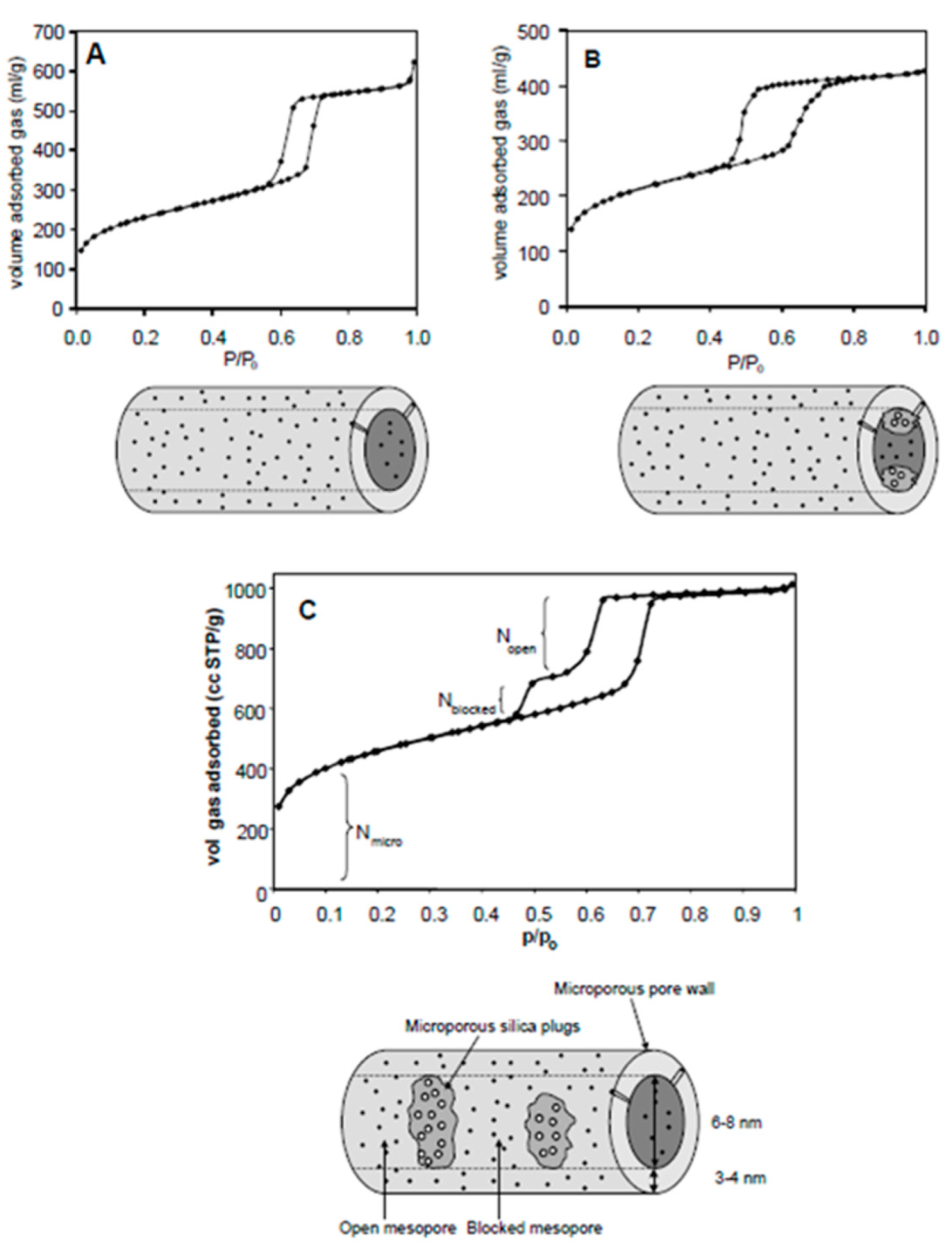
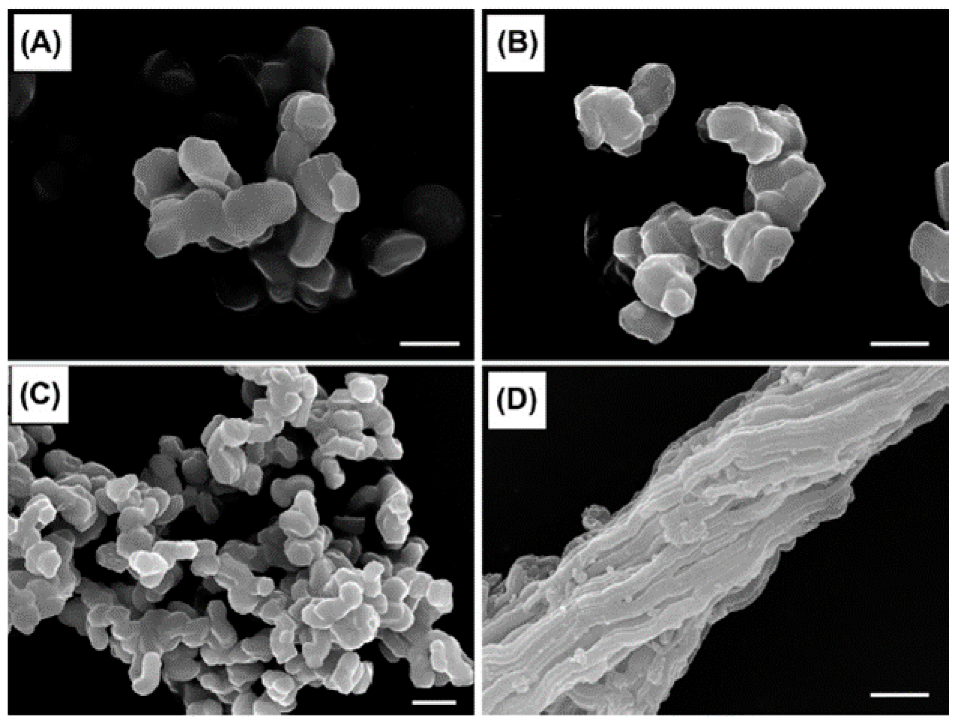
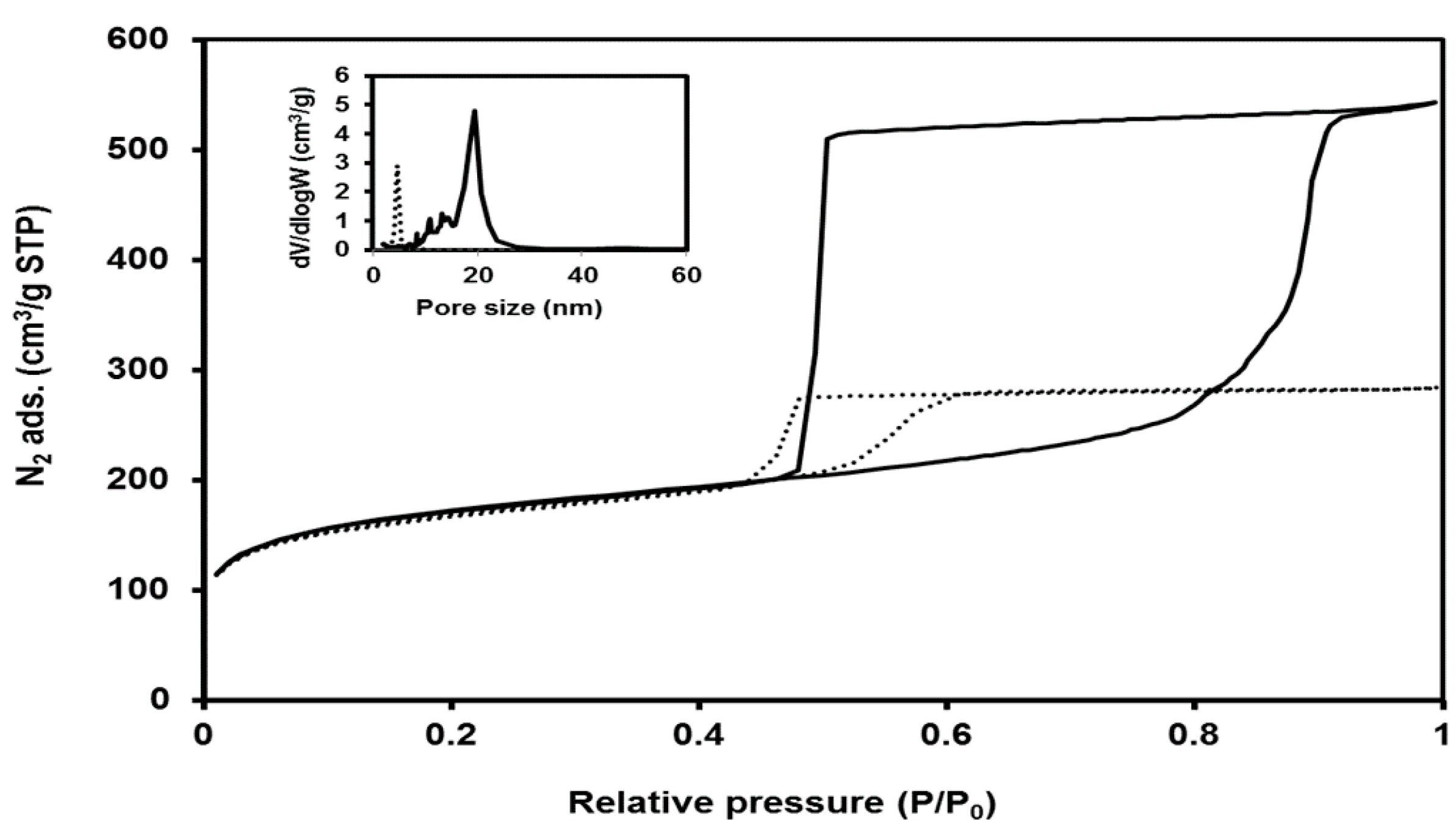
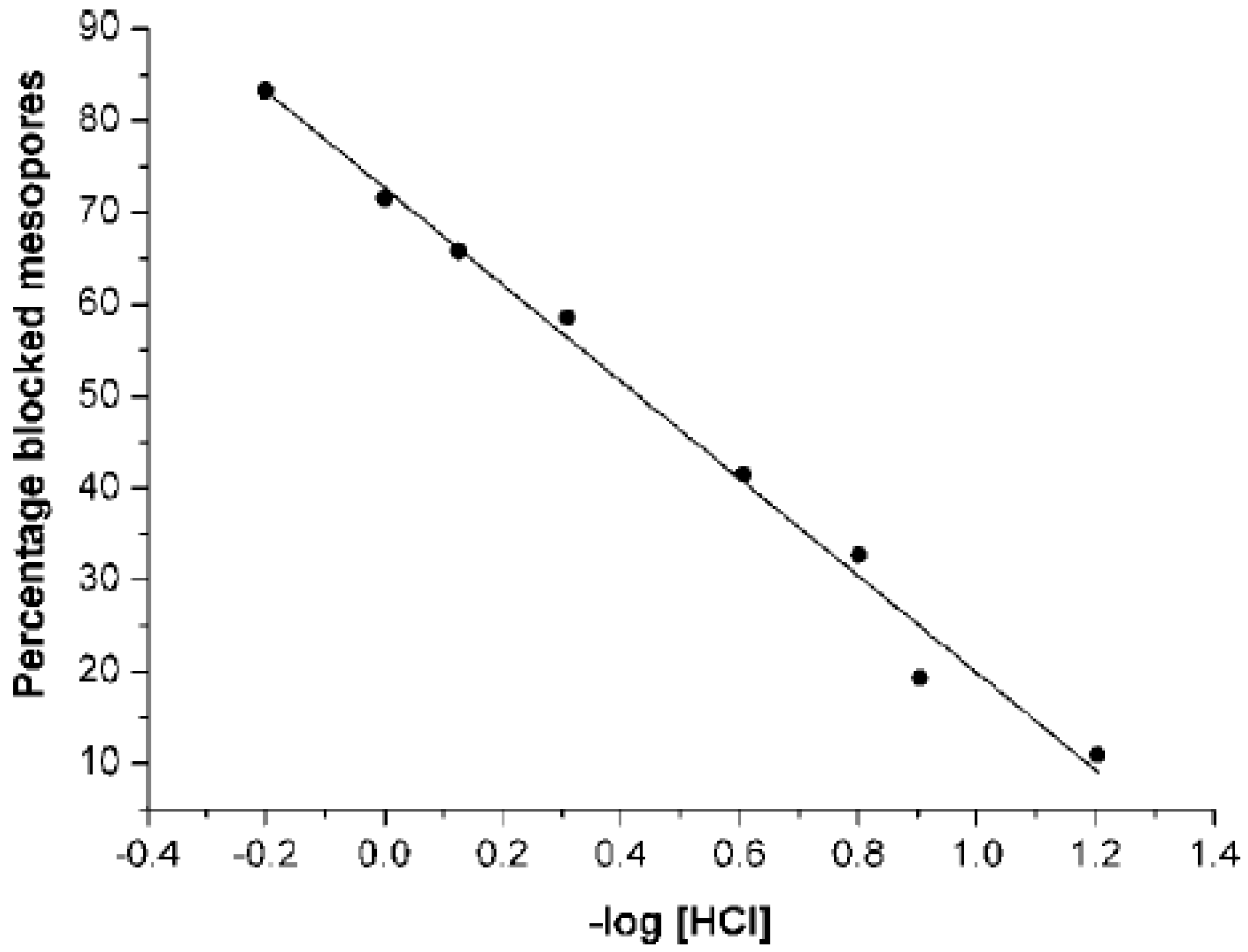
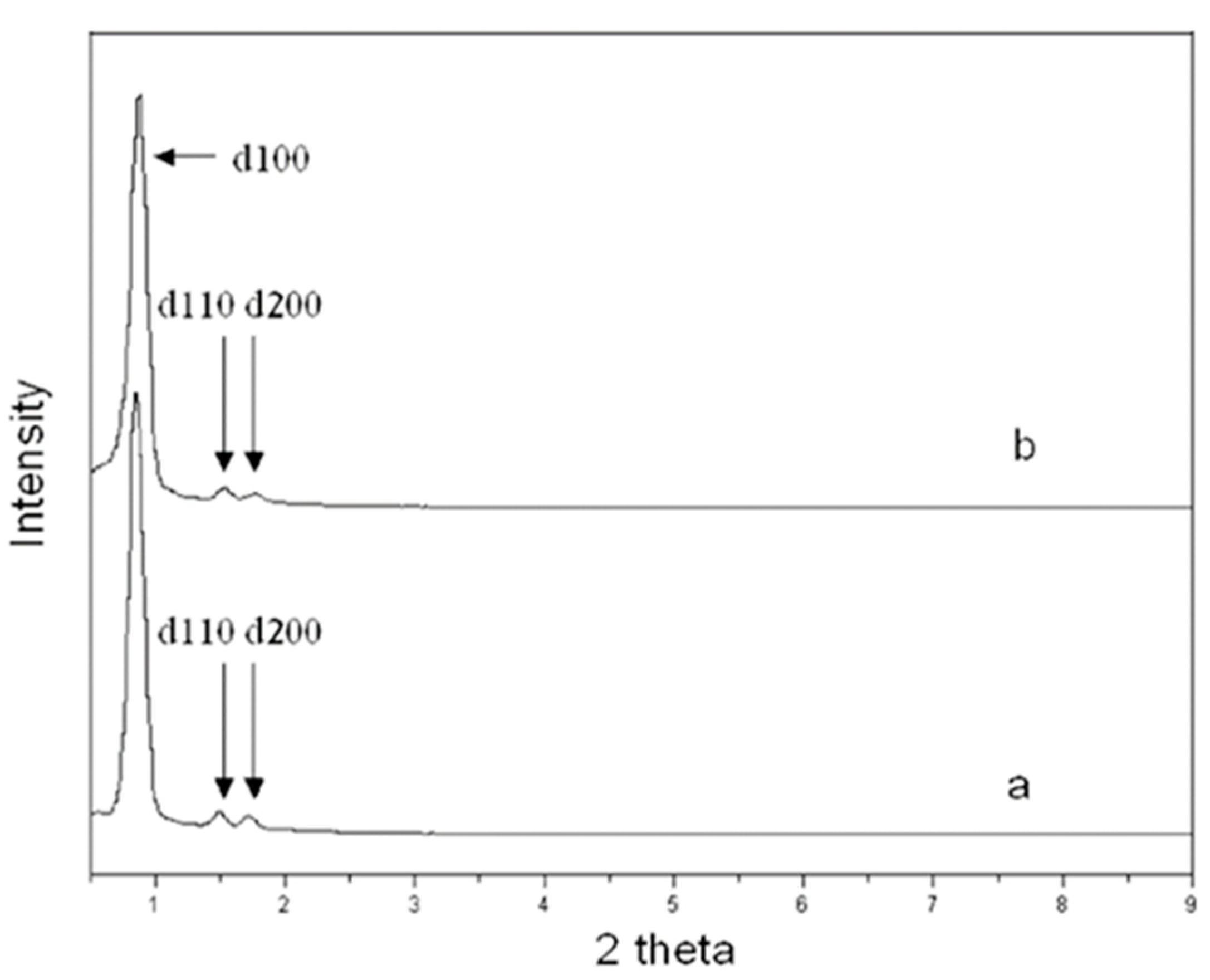
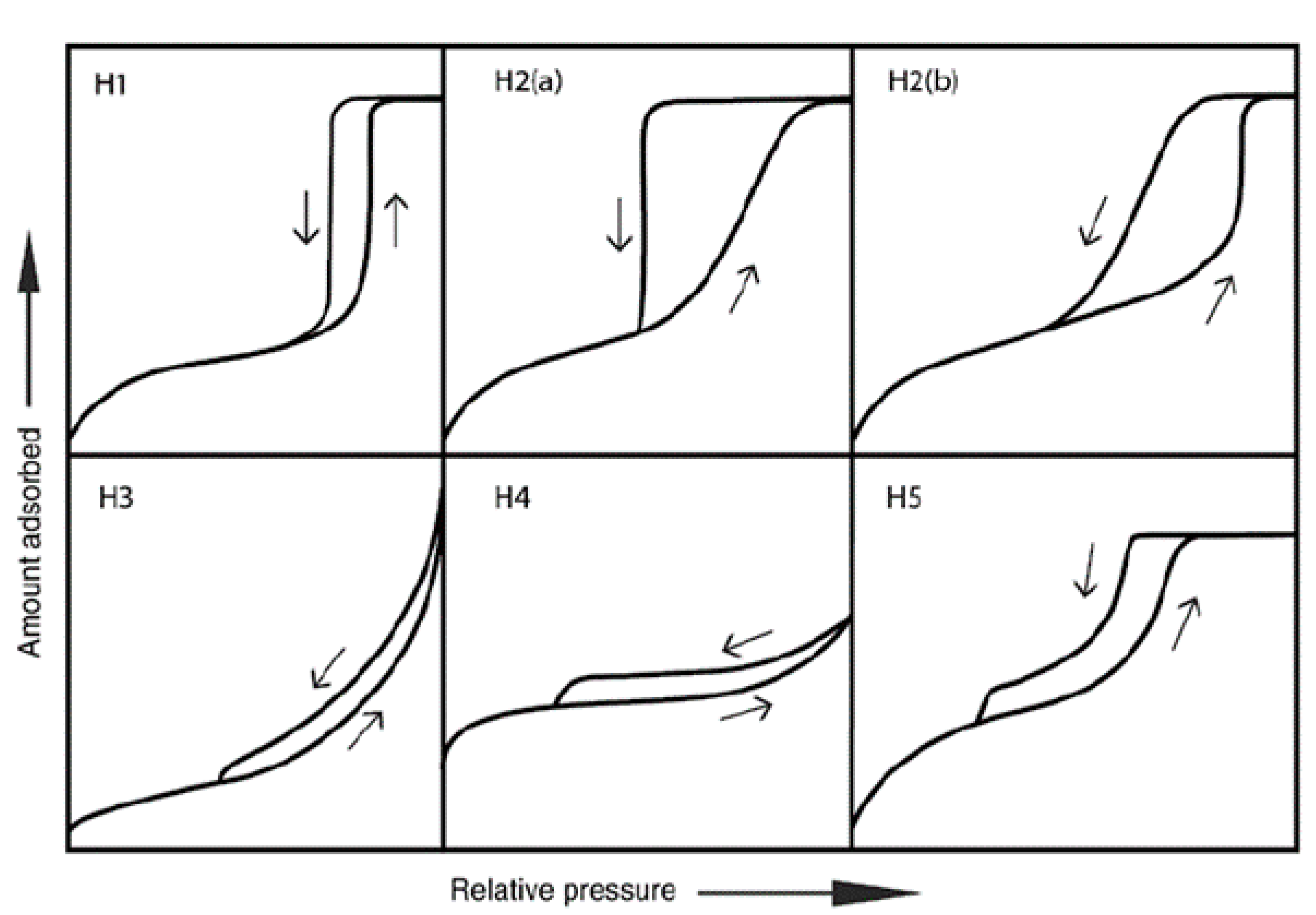
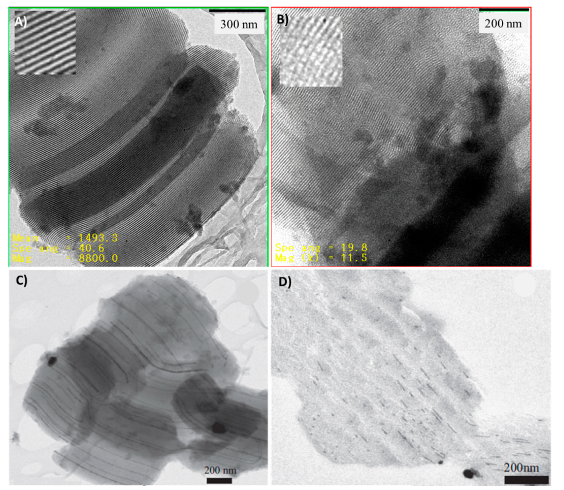
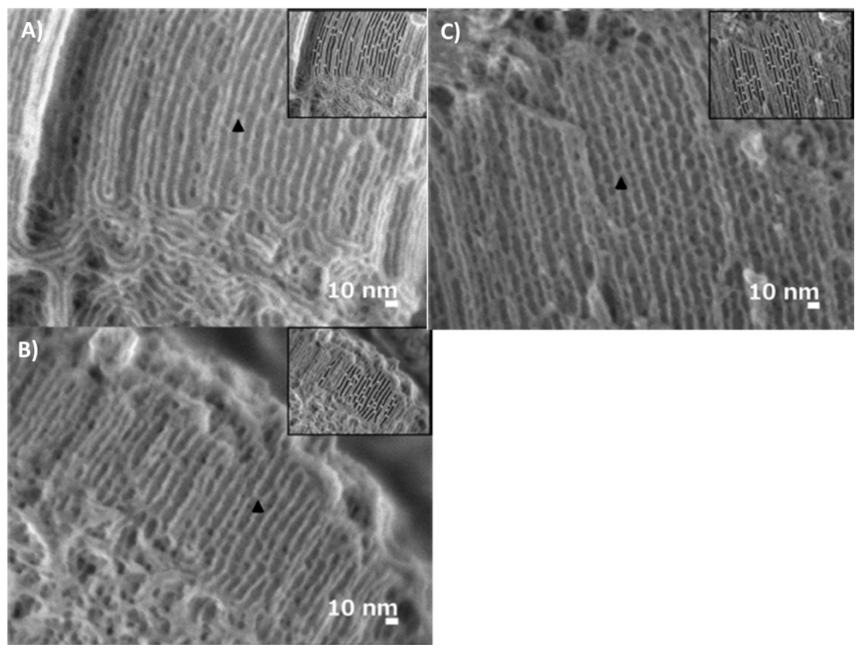
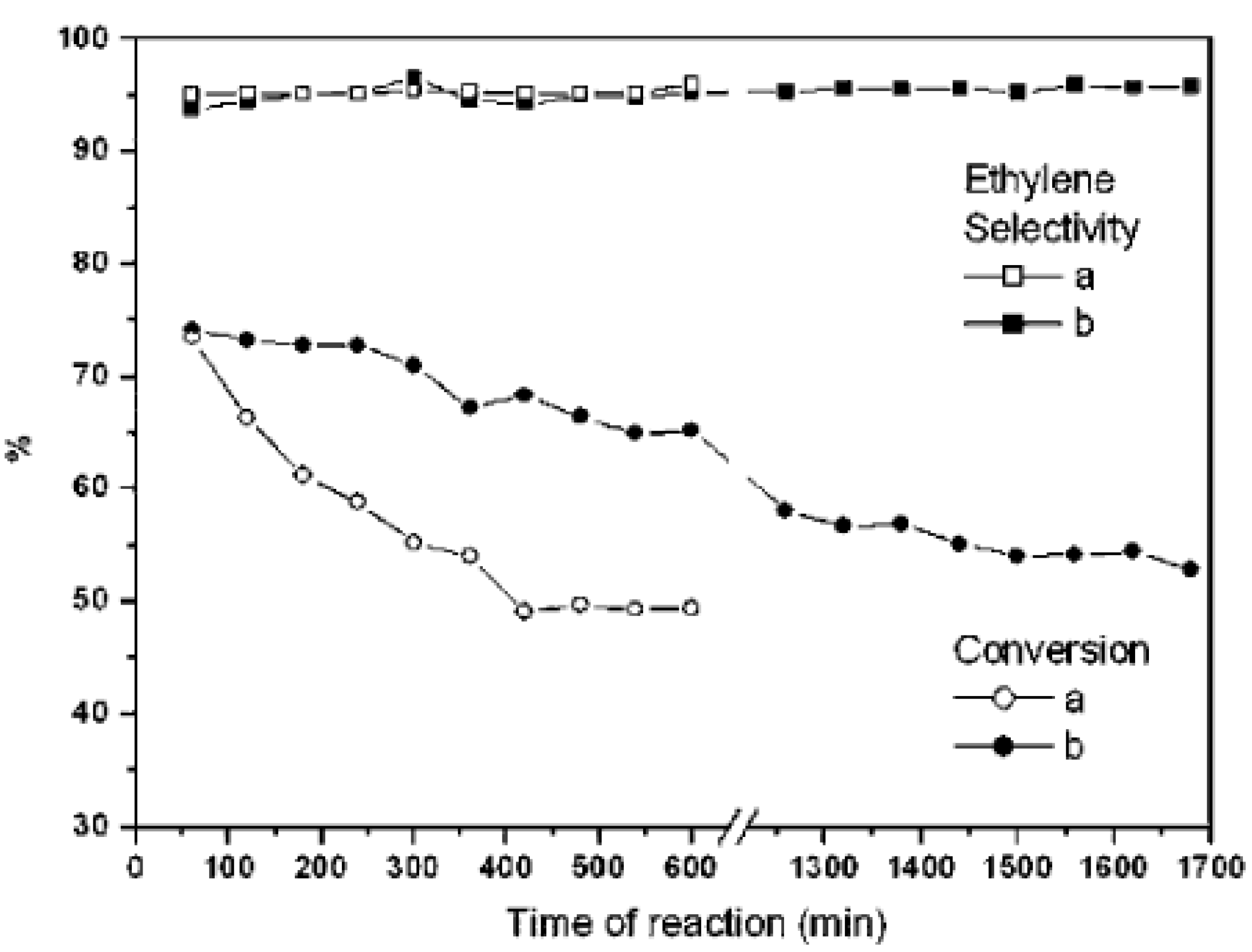
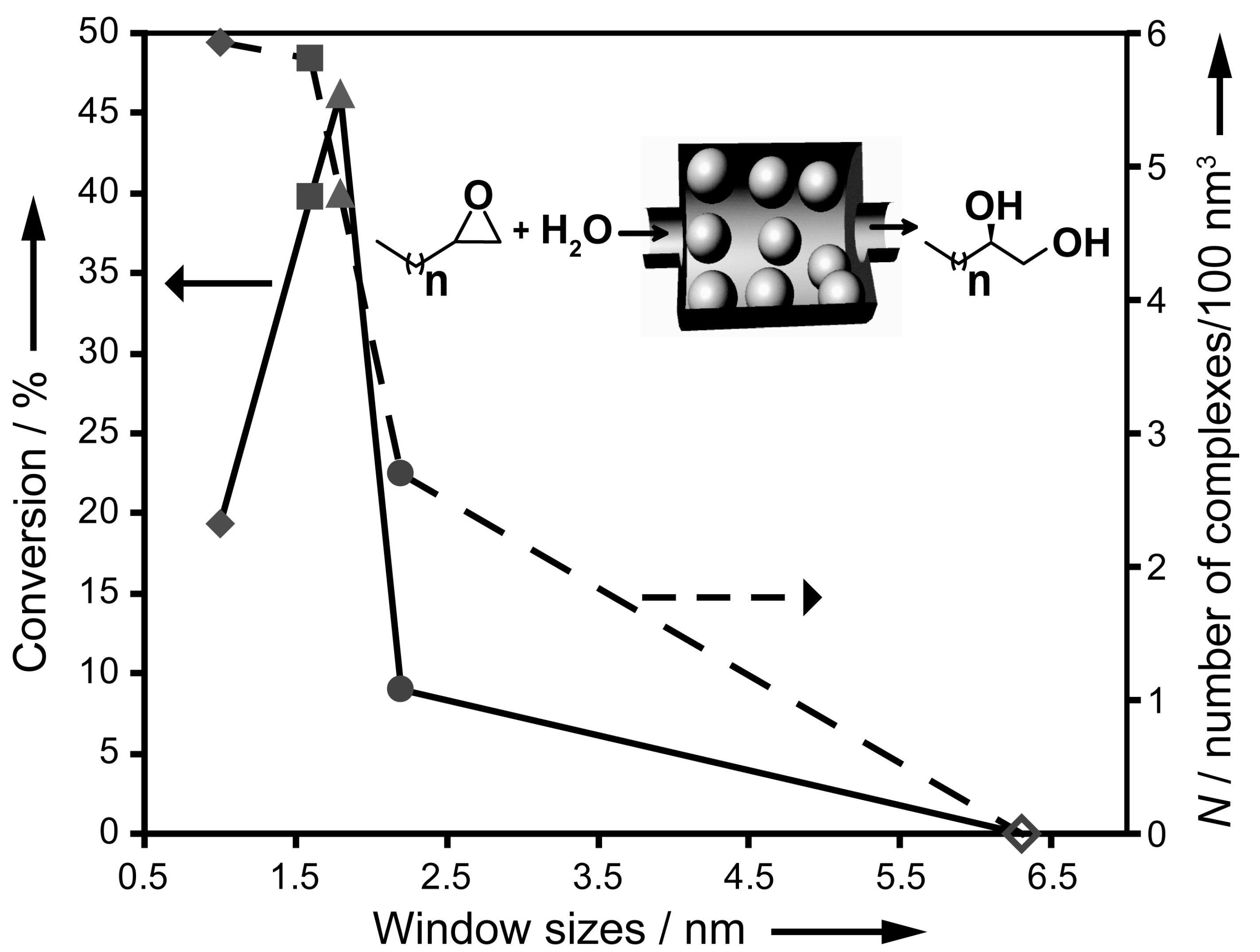
| No. | Si/P123 a | SBET (m2/g) b | Vtotal (cm3/g) c | Vmicropore (cm3/g) d | Strategy e | Maximum Vmeso, plugged (%) f | Ref. |
|---|---|---|---|---|---|---|---|
| 1 | 146 | 580 | 0.44 | 0.17 | Si/P123 control | ≈100 | [11] |
| 2 | 124 c | 640 | 0.7 | - | Two-step silica addition | ≈15 | [18] |
| 3 | 116 | 897 | 0.73 | 0.14 | One-step TEOS addition | ≈100 | [21] |
| 4 | 119 | 655 | 0.659 | 0.061 | Dual templating strategy | ≈100 | [22] |
| 5 | 50 | 836 | 0.85 | 0.18 | PCSA | ≈<10 | [19] |
| 6 | 55 | 783 | 0.91 | 0.126 | PCSA | ≈<10 | [20] |
| 7 | 60 | 806 | 1.07 | - | Two-step silica addition | ≈<10 | [23] |
| 8 | 60 | - | - | 0.15 | pH control | ≈83.3 | [24] |
| 9 | 290 | 961 | 0.76 | 0.26 | Si/P123 control | ≈100 | [25] |
Publisher’s Note: MDPI stays neutral with regard to jurisdictional claims in published maps and institutional affiliations. |
© 2021 by the authors. Licensee MDPI, Basel, Switzerland. This article is an open access article distributed under the terms and conditions of the Creative Commons Attribution (CC BY) license (https://creativecommons.org/licenses/by/4.0/).
Share and Cite
Shakeri, M.; Khatami Shal, Z.; Van Der Voort, P. An Overview of the Challenges and Progress of Synthesis, Characterization and Applications of Plugged SBA-15 Materials for Heterogeneous Catalysis. Materials 2021, 14, 5082. https://doi.org/10.3390/ma14175082
Shakeri M, Khatami Shal Z, Van Der Voort P. An Overview of the Challenges and Progress of Synthesis, Characterization and Applications of Plugged SBA-15 Materials for Heterogeneous Catalysis. Materials. 2021; 14(17):5082. https://doi.org/10.3390/ma14175082
Chicago/Turabian StyleShakeri, Mozaffar, ZeynabAlsadat Khatami Shal, and Pascal Van Der Voort. 2021. "An Overview of the Challenges and Progress of Synthesis, Characterization and Applications of Plugged SBA-15 Materials for Heterogeneous Catalysis" Materials 14, no. 17: 5082. https://doi.org/10.3390/ma14175082
APA StyleShakeri, M., Khatami Shal, Z., & Van Der Voort, P. (2021). An Overview of the Challenges and Progress of Synthesis, Characterization and Applications of Plugged SBA-15 Materials for Heterogeneous Catalysis. Materials, 14(17), 5082. https://doi.org/10.3390/ma14175082







